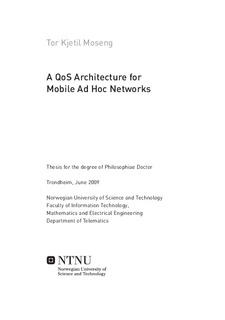| dc.contributor.author | Moseng, Tor Kjetil | nb_NO |
| dc.date.accessioned | 2014-12-19T14:11:37Z | |
| dc.date.available | 2014-12-19T14:11:37Z | |
| dc.date.created | 2009-08-21 | nb_NO |
| dc.date.issued | 2009 | nb_NO |
| dc.identifier | 232587 | nb_NO |
| dc.identifier.isbn | 978-82-471-1604-3 (printed ver.) | nb_NO |
| dc.identifier.isbn | 978-82-471-1605-0 (electronic ver.) | nb_NO |
| dc.identifier.uri | http://hdl.handle.net/11250/261503 | |
| dc.description.abstract | A Mobile Ad Hoc Network (MANET) is a shared wireless network without any infrastructure, consisting of mobile nodes connected by wireless links. The nodes are free to move and organize themselves arbitrarily. The nodes in the network are therefore depending on each other in order to communicate over multiple hops. Due to the physical characteristics of wireless networks, the channel is time-varying, which makes it hard to both predict and sustain a bit rate level. The nodes’ mobility causes topology changes, and further load and capacity variations. Traditional usage areas are battlefield and disaster areas, while new areas like extended network coverage and gaming are emerging.
Quality of Service (QoS) is needed in every network in order to differentiate traffic with different performance requirements, e.g. voice and e-mail applications. Providing QoS in wireless environments with varying conditions is complex, and hard guarantees can not be given. Consequently, the aim is to give differentiated treatment to traffic with different performance requirements. In addition, we can not study the MANET without considering fixed networks. Communication with fixed networks is important, for example by accessing the Internet.
In this thesis the Differentiated Services (DiffServ) architecture is applied and adapted to MANETs. Using the same QoS architecture will ease the transition between the wireless and wired domain. But the special characteristics of wireless networks require modifications to the original DiffServ architecture. In investigations there was found restrictions on the number of classes to use, and this number was dependent on the type of traffic in the network. A QoS architecture based on the DiffServ framework is proposed, with an admission control based on the concept of shadow classes, and Explicit Congestion Notification (ECN) to avoid congestion. New flows are tested in a shadow class before getting admission to the network and its designated class. The shadow class has the same scheduling properties as the designated class, but is differentiated by a higher drop probability in the buffers. Both the admission control and ECN are thus build on the same principle by controlling the load from probabilistic functions in the buffers, and are studied to find their individual and combined effects.
In wireless environments the probability of a packet loss increases with the number of hops, which gives services an unpredictable performance for users. A predictable service, independent of number of hops, is provided by scheduling based on the path information; the packets are differentiated based on the number of hops made or left to make, increasing the predictability at the cost of performance. | nb_NO |
| dc.language | eng | nb_NO |
| dc.publisher | Norges teknisk-naturvitenskapelige universitet, Fakultet for informasjonsteknologi, matematikk og elektroteknikk, Institutt for telematikk | nb_NO |
| dc.relation.ispartofseries | Doktoravhandlinger ved NTNU, 1503-8181; 2009:111 | nb_NO |
| dc.subject | Admission control | en_GB |
| dc.subject | congestion control | en_GB |
| dc.subject | DiffServ | en_GB |
| dc.subject | ECN | en_GB |
| dc.subject | fairness | en_GB |
| dc.subject | mobile ad | en_GB |
| dc.title | A QoS Architecture for Mobile Ad Hoc Networks | nb_NO |
| dc.type | Doctoral thesis | nb_NO |
| dc.contributor.department | Norges teknisk-naturvitenskapelige universitet, Fakultet for informasjonsteknologi, matematikk og elektroteknikk, Institutt for telematikk | nb_NO |
| dc.description.degree | PhD i informasjons- og kommunikasjonsteknologi | nb_NO |
| dc.description.degree | PhD in Information and Communications Technology | en_GB |

